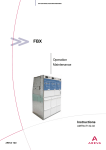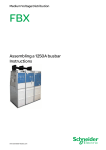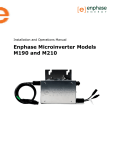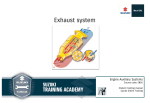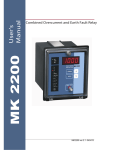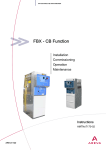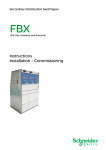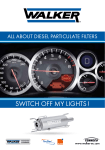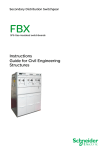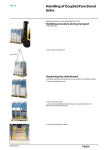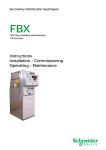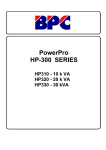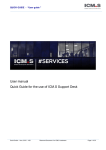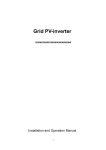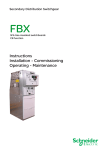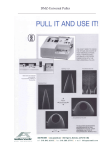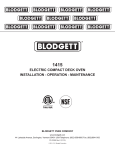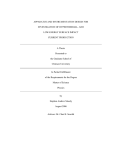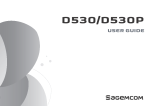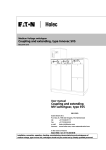Download AMTNoT132-02 SE - Schneider Electric
Transcript
Secondary Distribution Switchgear FBX SF6 Gas-insulated switchboards Instructions Operation - Maintenance FBX AMTNoT132-02 revision: 04 Contents 1 Schneider Electric at your service . . . . . . . . . . . . . . . . . . . 1 1.1 1.2 Our Service Unit: our specialists, and suitably adapted services... . . . . . . . . . Schneider Electric Training: Together, let us develop our skills... . . . . . . . . . . . 1 1 2 With regards to this User Manual . . . . . . . . . . . . . . . . . . . . 2 2.1 2.2 2 2.3 2.4 2.5 Responsibilities . . . . . . . . . . . . . . . . . . . . . . . . . . . . . . . . . . . . . . . . . . . . . . . . . . . Particular instructions for operations and interventions on energized equipment . . . . . . . . . . . . . . . . . . . . . . . . . . . . . . . . . . . . . . . . . . . . . . . . . . . . . . . . Other technical notices to be consulted . . . . . . . . . . . . . . . . . . . . . . . . . . . . . . . . Tools (not supplied) required for the operations described in this user manual Symbols & conventions . . . . . . . . . . . . . . . . . . . . . . . . . . . . . . . . . . . . . . . . . . . . . 2 2 2 2 3 Functional interlocks . . . . . . . . . . . . . . . . . . . . . . . . . . . . . . . 3 3.1 3.2 3.3 3.4 Functional mechanical interlocks . . . . . . . . . . . . . . . . . . . . . . . . . . . . . . . . . . . . . Interlocks for functions C and T1 . . . . . . . . . . . . . . . . . . . . . . . . . . . . . . . . . . . . . Interlocks for function T2 . . . . . . . . . . . . . . . . . . . . . . . . . . . . . . . . . . . . . . . . . . . . Interlocks for function Sb . . . . . . . . . . . . . . . . . . . . . . . . . . . . . . . . . . . . . . . . . . . 3 3 3 3 4 Operating accessories . . . . . . . . . . . . . . . . . . . . . . . . . . . . . . 4 4.1 4.2 4.3 Reminder for Manual Operations . . . . . . . . . . . . . . . . . . . . . . . . . . . . . . . . . . . . . Operating accessories . . . . . . . . . . . . . . . . . . . . . . . . . . . . . . . . . . . . . . . . . . . . . Lockouts using padlocks (Optional) . . . . . . . . . . . . . . . . . . . . . . . . . . . . . . . . . . . 4 4 4 5 Use of the RE function . . . . . . . . . . . . . . . . . . . . . . . . . . . . . . 5 5.1 5.2 Opening the earthing switch . . . . . . . . . . . . . . . . . . . . . . . . . . . . . . . . . . . . . . . . . Closing the earthing switch . . . . . . . . . . . . . . . . . . . . . . . . . . . . . . . . . . . . . . . . . . 5 5 6 Use of the C function . . . . . . . . . . . . . . . . . . . . . . . . . . . . . . . 6 6.1 6.2 6.3 6.4 6.5 Opening the earthing switch . . . . . . . . . . . . . . . . . . . . . . . . . . . . . . . . . . . . . . . . . Closing the earthing switch . . . . . . . . . . . . . . . . . . . . . . . . . . . . . . . . . . . . . . . . . . Closing the load break switch . . . . . . . . . . . . . . . . . . . . . . . . . . . . . . . . . . . . . . . . Opening the load break switch . . . . . . . . . . . . . . . . . . . . . . . . . . . . . . . . . . . . . . . Movements of motorised control mechanisms . . . . . . . . . . . . . . . . . . . . . . . . . . 6 6 7 7 7 7 Use of the T1 function . . . . . . . . . . . . . . . . . . . . . . . . . . . . . . 8 7.1 7.2 7.3 7.4 7.5 Opening the earthing switch . . . . . . . . . . . . . . . . . . . . . . . . . . . . . . . . . . . . . . . . . Closing the earthing switch . . . . . . . . . . . . . . . . . . . . . . . . . . . . . . . . . . . . . . . . . . Closing the load break switch . . . . . . . . . . . . . . . . . . . . . . . . . . . . . . . . . . . . . . . . Manually opening the load break switch . . . . . . . . . . . . . . . . . . . . . . . . . . . . . . . Movements of motorised control mechanisms . . . . . . . . . . . . . . . . . . . . . . . . . . 8 8 8 8 8 8 Use of the T2 function . . . . . . . . . . . . . . . . . . . . . . . . . . . . . . 9 8.1 8.2 8.3 8.4 8.5 8.6 8.7 8.8 Opening the earthing switch . . . . . . . . . . . . . . . . . . . . . . . . . . . . . . . . . . . . . . . . . Closing the earthing switch . . . . . . . . . . . . . . . . . . . . . . . . . . . . . . . . . . . . . . . . . . Closing the line isolating switch [circuit breaker open] . . . . . . . . . . . . . . . . . . . . Opening the line isolating switch [circuit breaker open] . . . . . . . . . . . . . . . . . . . Closing the circuit breaker [Line Isolator closed] . . . . . . . . . . . . . . . . . . . . . . . . Opening the circuit breaker [Line Isolator closed] . . . . . . . . . . . . . . . . . . . . . . . Closing the circuit breaker [Line Isolator open] . . . . . . . . . . . . . . . . . . . . . . . . . . Movements of motorised control mechanisms . . . . . . . . . . . . . . . . . . . . . . . . . . 9 9 9 9 10 10 10 10 9 Use of Function Sb . . . . . . . . . . . . . . . . . . . . . . . . . . . . . . . . . 11 9.1 9.2 9.3 9.4 9.5 Opening the earthing switch . . . . . . . . . . . . . . . . . . . . . . . . . . . . . . . . . . . . . . . . . Closing the earthing switch . . . . . . . . . . . . . . . . . . . . . . . . . . . . . . . . . . . . . . . . . . Closing the load break switch . . . . . . . . . . . . . . . . . . . . . . . . . . . . . . . . . . . . . . . . Opening the load break switch . . . . . . . . . . . . . . . . . . . . . . . . . . . . . . . . . . . . . . . Movements of motorised control mechanisms . . . . . . . . . . . . . . . . . . . . . . . . . . 11 11 11 11 11 10 Using motorised functions . . . . . . . . . . . . . . . . . . . . . . . . . . 12 10.1 10.2 10.3 10.4 10.5 10.6 Movements of motorised control mechanisms [Optional] . . . . . . . . . . . . . . . . . Manual emergency movements of motorised controls . . . . . . . . . . . . . . . . . . . . Approximate number of turns for backup manual control levers . . . . . . . . . . . . Manual interventions involving Functions C and Sb [Earthing switch open] . . Manual interventions involving Function T1 [Earthing switch open] . . . . . . . . . Manual interventions involving Function T2 [Earthing switch open] . . . . . . . . . 12 12 12 12 13 13 11 Maintenance . . . . . . . . . . . . . . . . . . . . . . . . . . . . . . . . . . . . . . . 14 11.1 11.2 Levels of maintenance . . . . . . . . . . . . . . . . . . . . . . . . . . . . . . . . . . . . . . . . . . . . . Preventive maintenance . . . . . . . . . . . . . . . . . . . . . . . . . . . . . . . . . . . . . . . . . . . . 14 14 i FBX 11.3 11.4 11.5 11.6 Corrective maintenance . . . . . . . . . . . . . . . . . . . . . . . . . . . . . . . . . . . . . . . . . . . . Replacement of the three fuses . . . . . . . . . . . . . . . . . . . . . . . . . . . . . . . . . . . . . . Replacement of a fuse . . . . . . . . . . . . . . . . . . . . . . . . . . . . . . . . . . . . . . . . . . . . . When using under 12 kV . . . . . . . . . . . . . . . . . . . . . . . . . . . . . . . . . . . . . . . . . . . . Replacement of a voltage indicator unit [E.g.: Type VPIS] . . . . . . . . . . . . . . . . Periodic frequency for maintenance operations of the VDS boxes . . . . . . . . . 14 14 14 16 16 17 12 Spare parts . . . . . . . . . . . . . . . . . . . . . . . . . . . . . . . . . . . . . . . . 18 12.1 12.2 12.3 The spare part . . . . . . . . . . . . . . . . . . . . . . . . . . . . . . . . . . . . . . . . . . . . . . . . . . . . Identification of materials . . . . . . . . . . . . . . . . . . . . . . . . . . . . . . . . . . . . . . . . . . . . Storage conditions . . . . . . . . . . . . . . . . . . . . . . . . . . . . . . . . . . . . . . . . . . . . . . . . . 18 18 18 13 Cable testing . . . . . . . . . . . . . . . . . . . . . . . . . . . . . . . . . . . . . . . 19 13.1 13.2 13.3 Preparation of the function . . . . . . . . . . . . . . . . . . . . . . . . . . . . . . . . . . . . . . . . . . Cable testing with plug-in `T' piece connectors (busbar energised) . . . . . . . . . Cable tests: EON specification with plug-in 'T' piece connectors [busbar energised] . . . . . . . . . . . . . . . . . . . . . . . . . . . . . . . . . . . . . . . . . . . . . . . . . Testing the casing of plug-in connectors . . . . . . . . . . . . . . . . . . . . . . . . . . . . . . . 19 19 14 Characteristics and Volumes of SF6 gas . . . . . . . . . . . . . 21 14.1 14.2 14.3 14.4 General characteristics . . . . . . . . . . . . . . . . . . . . . . . . . . . . . . . . . . . . . . . . . . . . . Filling pressure . . . . . . . . . . . . . . . . . . . . . . . . . . . . . . . . . . . . . . . . . . . . . . . . . . . . Operating thresholds of the pressure gauge contacts . . . . . . . . . . . . . . . . . . . . FBX functions . . . . . . . . . . . . . . . . . . . . . . . . . . . . . . . . . . . . . . . . . . . . . . . . . . . . . 21 21 21 21 15 At the end of the equipment's operational life . . . . . . . . 22 15.1 15.2 15.3 15.4 Valorization of the equipment . . . . . . . . . . . . . . . . . . . . . . . . . . . . . . . . . . . . . . . . Safety instructions . . . . . . . . . . . . . . . . . . . . . . . . . . . . . . . . . . . . . . . . . . . . . . . . . Dismantling of the equipment service . . . . . . . . . . . . . . . . . . . . . . . . . . . . . . . . . Distribution and valorization of the materials used for FBX (See § 15.1) . . . . . 22 22 22 23 16 Notes . . . . . . . . . . . . . . . . . . . . . . . . . . . . . . . . . . . . . . . . . . . . . . 24 13.4 ii 20 20 AMTNoT132-02 revision: 04 FBX 1 Schneider Electric at your service Operations and maintenance may only be carried out by personnel who have received suitable authorisation for the operations and manœuvres they are responsible for performing. If this is not the case, please refer to our Service Unit or Training Centre. 1.1 All locking-out operations must be performed according to the ”General Safety Instructions booklet for Electrical Applications” UTE C 18 510 (or its equivalent outside FRANCE). Our Service Unit: our specialists, and suitably adapted services... Guarantee extension contracts in relation to the selling of new equipment, Supervision of HVA switchgear installations, Technical advice, diagnoses of the facilities, expertise, Maintenance contracts adapted to operational constraints, Systematic or conditional preventive maintenance, Corrective maintenance in case of partial or complete failure, Supply of spare parts, Overhauling of equipment and requalification of installations in order to benefit from new technologies and extend the life of your switchgear by limited investments. J J J J J J J J Contact the Schneider Electric Service Unit for diagnoses and advice: Working hours ) 33 (0)3 85 29 35 00 33 (0)3 85 29 36 30 or 33 (0)3 85 29 36 43 1.2 Schneider Electric Training: Together, let us develop our skills... We can place at your disposal all of our trainers' expertise, our teams' pedagogical experience and the wealth of our equipment, to help you face the challenge of encouraging the personal development of each individual through the optimisation of their skills. From a few hours up to several weeks, Schneider Electric Training has the control over all of the teaching processes in order to meet the needs of each customer. J J J J Specific training, directly operational with practical work on real machines. Small groups to facilitate communication. Balance between theory and practice. Evaluation and management of the skills: Measurement and optimisation of the trainees' knowledge. Faced with the direct and indirect training costs of the operational stoppages and shutdown, training is a real investment Schneider Electric France Training Centre 35 rue Joseph Monier - CS 30323 - F-92506 Rueil-Malmaison Cedex www.schneider-electric.fr/formation AMTNoT132-02 revision: 04 1 FBX 2 With regards to this User Manual © - Schneider Electric - 2010. Schneider Electric, the Schneider Electric logo and their figurative forms are Schneider Electric registered trademarks. The other brand names mentioned within this document, whether they be copyright or not, belong to their respective holders. 2.1 Responsibilities Our devices are quality controlled and tested at the factory in accordance with the standards and the regulations currently in force. Apparatus efficiency and apparatus life depend on the compliance with the installation, commissioning and operation instructions described in this user manual. Non respect of these instructions is likely to invalidate any guarantee. Local requirements especially about safety and which are in accordance with the indications given in this document, must be observed. 2.2 J All manipulations must be completed once started. The durations (for completing the operations mentioned) given in the maintenance tables are purely an indication and depend on on-site conditions. Other technical notices to be consulted AMTNoT131-02 2.4 This user manual does not list the locking-out procedures that must be applied. The interventions described are carried out on de-energized equipment (in the course of being installed) or locked out (non operational). Particular instructions for operations and interventions on energized equipment When commissioning and operating the equipment under normal conditions, the General safety instructions for electrical applications must be respected, (protective gloves, insulating stool, etc.), in addition to standard operating instructions. 2.3 Schneider Electric declines any responsibility for the consequences: - due to the non respect of the recommendations in this manual which make reference to the international regulations in force. - due to the non respect of the instructions by the suppliers of cables and connection accessories during installation and fitting operations, - of any possible aggressive climatic conditions (humidity, pollution, etc.) acting in the immediate environment of the materials that are neither suitably adapted nor protected for these effects. FBX SF6 Gas-insulated switchboards Installation - Commissioning Tools (not supplied) required for the operations described in this user manual - Flat, thin screwdriver (4) + medium - Leather gloves 2.5 2 Symbols & conventions 06 - Code for a product recommended and marketed by Schneider Electric CAUTION! Remain vigilant! Precautions to be taken in ATTENTION order to avoid accidents or injury 21 Nm - Tightening torque value Example: 21 Nm FORBIDDEN! Do not do it! Compliance with this indication is compulsory, non compliance with this stipulation may damage the equipment. 10 - Mark corresponding to a key INFORMATION - ADVICE Your attention is drawn to a specific point or operation. AMTNoT132-02 revision: 04 FBX 3.1 3 Functional interlocks Functional mechanical interlocks The FBX switchboard is equipped with internal mechanical interlocks, called ”functional”, intended to avoid any kind of operating error. 3.2 Earthing switch Access hatch to fuse electrodes or cables Position Load Break Switch Earthing switch Access hatch to fuse electrodes or cables Closed - Locked open Locked closed Open - Free Dependant on the position of the earthing switch Closed Locked open - Free Open Free - Locked closed Open Locked open Locked closed - Interlocks for function T2 Circuit breaker Disconnector switch Earthing switch Access panel to the cable compartment 3.4 Function Sb: The disconnection or earthing operation can only be carried out once suitably adapted lockout operations have been implemented on the network. Interlocks for functions C and T1 Load Break Switch 3.3 It is necessary to know these interlocks in order to operate the switchgear correctly. Position Circuit breaker Disconnector switch Earthing switch Access cover to cable compartment Closed - Locked (closed or open) Locked open Locked closed Open - Free Dependant on the position of the disconnector switch Dependant on the position of the earthing switch Closed Free - Locked open Locked closed Open Free (Normally Open) - Free Dependant on the position of the earthing switch Closed Free (Normally Open) Locked open - Free Open Free (Normally Open) Dependant on the position of the circuit breaker - Locked closed Open Free (Normally Open) Locked open Locked Closed - Interlocks for function Sb Disconnector switch Earthing switch AMTNoT132-02 revision: 04 Position Disconnector switch Earthing switch Closed - Locked open Open - Free Closed Locked open - Open Free - 3 FBX 4.1 4 Operating accessories Reminder for Manual Operations The operating manoeuvres are made without any special effort. Nevertheless, the force required is greater for latching controls (T1, T2) than for tumbler switches (C). 4.2 The lever moves through approximately 95°. Operating accessories J Standard operating lever for the earthing switch (red end). J Emergency manual control lever for motorised mechanisms. 4.3 All movements of the lever must be frank and complete. J Standard operating lever for the load-break switch (black end). J Fuse electrode compartment key. Lockouts using padlocks (Optional) Optional: Each mechanical control hub can be fitted so as to allow it to be locked out using a padlock (not supplied). 4 AMTNoT132-02 revision: 04 FBX 5.1 J J 5 Use of the RE function Opening the earthing switch Check that the tag is fully lowered. Insert the appropriate lever (red end) into the earthing switch socket. 5.2 J Grasp the lever with both hands. J J Lift the lever: the earthing switch is now in the open position. Remove the lever. Closing the earthing switch Before closing the earthing switch, ensure there is no voltage across the indicator units (see corresponding manual - § 2.3). J J Check that the tag is fully lowered. Insert the appropriate lever (red end) into the earthing switch socket. AMTNoT132-02 revision: 04 J Grasp the lever with both hands. J J Pull the lever down: the earthing switch is closed. Remove the lever. 5 FBX 6.1 J J 6 Use of the C function Opening the earthing switch Check that the tag is fully lowered. Insert the appropriate lever (red end) into the earthing switch socket. 6.2 J Grasp the lever with both hands. J J Lift the lever: the earthing switch is now in the open position. Remove the lever. Closing the earthing switch Before closing the earthing switch, ensure there is no voltage across the indicator units (see corresponding manual - § 2.3). J J J 6 Check that the tag is fully lowered. Hold the locking tab open to the right. Insert the appropriate lever (red end) into the earthing switch socket. J Grasp the lever with both hands. J J Pull the lever down: the earthing switch is closed. Remove the lever. AMTNoT132-02 revision: 04 FBX 6.3 J Insert the appropriate lever (black end) into the load-break switch socket. 6.4 J Closing the load break switch J Grasp the lever with both hands. J J Opening the load break switch Insert the appropriate lever (black end) into the load-break switch socket. J Grasp the lever with both hands. J J 6.5 Lift the lever: The switch is now closed. Remove the lever. Pull the lever down: The switch is now open. Remove the lever. Movements of motorised control mechanisms See chapter 10. AMTNoT132-02 revision: 04 7 FBX 7.1 7 Use of the T1 function Opening the earthing switch See instructions in § 6.1. 7.2 Closing the earthing switch See instructions in § 6.2. 7.3 J J Closing the load break switch Insert the appropriate lever (black end) into the load-break switch socket. Grasp the lever with both hands. 7.4 J Lower the lever to its lowest position and release slowly (to ensure that the latch is engaged): The switch is now held permanently open. J J Lift the lever fully: The switch is now closed. Remove the lever. Manually opening the load break switch NB: The switch can also be opened using a push-button (optional) or an electrical control. J Insert the appropriate lever (black end) into the load-break switch socket. J Grasp the lever with both hands. J J 7.5 Lower the lever through approximately 20°: The switch is now open. Remove the lever. Movements of motorised control mechanisms See chapter 10. 8 AMTNoT132-02 revision: 04 FBX 8.1 8 Use of the T2 function Opening the earthing switch See instructions in § 6.1. 8.2 Closing the earthing switch See instructions in § 6.2. 8.3 J J Lift the locking tab. Insert the appropriate lever (black end) into the disconnector switch socket. 8.4 J J Closing the line isolating switch [circuit breaker open] J Grasp the lever with both hands. J J Lift the lever: The line isolator is now closed. Remove the lever. Opening the line isolating switch [circuit breaker open] Lift the locking tab. Insert the appropriate lever (black end) into the disconnector switch socket. AMTNoT132-02 revision: 04 J Grasp the lever with both hands. J J Pull the lever down: The line isolator is now open. Remove the lever. 9 FBX 8.5 J J Closing the circuit breaker [Line Isolator closed] Insert the appropriate lever (black end) into the circuit breaker socket. Grasp the lever with both hands. 8.6 J Lower the lever to its lowest position and release slowly (to ensure that the hold-open latch is engaged): The switch is now held permanently open. J J Lift the lever fully: The circuit breaker is now closed. Remove the lever. Opening the circuit breaker [Line Isolator closed] NB: The switch can also be opened using a push-button (optional) or an electrical control. J Insert the appropriate lever (black end) into the circuit breaker socket. J Grasp the lever with both hands. J J 8.7 Closing the circuit breaker [Line Isolator open] It is also possible to operate the CB when the line isolator is open. 8.8 Lower the lever through approximately 20°: The circuit breaker is now open. Remove the lever. This `no-load' operation can be used to test and ensure that the circuit breaker is functioning correctly. Movements of motorised control mechanisms See chapter 10. 10 AMTNoT132-02 revision: 04 FBX 9.1 9 Use of Function Sb Opening the earthing switch Follow the instructions given in § 6.1. 9.2 Closing the earthing switch The disconnection or earthing opera‐ tion can only be carried out once suit‐ ably adapted lockout operations have been implemented on the network. 9.3 Before closing the earthing switch, ensure there is no voltage (or current) across the circuit in question (see corresponding manual - § 2.3). Follow the instructions given in § 6.2. Closing the load break switch Follow the instructions given in § 6.3. 9.4 Opening the load break switch Follow the instructions given in § 6.4. 9.5 Movements of motorised control mechanisms Se reporter au chapitre 10. AMTNoT132-02 revision: 04 11 FBX 10 Using motorised functions 10.1 Movements of motorised control mechanisms [Optional] If the FBX switchboard is fitted with motorised controls (optional), the various functions can be energised/de-energised remotely in accordance with the circuit diagram supplied as part of the contract. For functions T1 and T2, opening operations can also be triggered by a push-button (optional) or electrical controls. Function Sb: The disconnection or earthing operation can only be carried out once suitably adapted lockout operations have been implemented on the network. 10.2 Manual emergency movements of motorised controls In the event of an outage of the motor supply source, a back-up control can be used to complete a manoeuvre underway or to carry out manual manoeuvres. The position of the indicators should be verified after each operation. If the supply is re-established whilst the handle is inserted, it will be pushed out of the socket. When the earthing switch is closed the backup manual control lever can‐ not be fitted (Except for CB T2). 10.3 Approximate number of turns for backup manual control levers Switch Disconnector Circuit breaker To Open To Close Functions C and Sb 31 turns 31 turns Function T1 7 turns 50 turns Function T2 31 turns 31 turns To Open To Close 7 turns 50 turns 10.4 Manual interventions involving Functions C and Sb [Earthing switch open] J Insert the backup handle for the switch into its hole. J To open (or close) the load-break switch, turn clockwise (See § 10.3). J J 12 Continue until the operation is completed (mimic diagram changes). Remove the crank handle. AMTNoT132-02 revision: 04 FBX 10.5 Manual interventions involving Function T1 [Earthing switch open] J Insert the backup handle for the switch into its hole. J To open (or close) the load-break switch, turn clockwise (See § 10.3). J J Continue until the operation is completed (mimic diagram changes). Remove the crank handle. 10.6 Manual interventions involving Function T2 [Earthing switch open] o J Insert the backup handle for the switch into its hole. J To open (or close) the load-break switch, turn clockwise (See § 10.3). I J J AMTNoT132-02 revision: 04 Continue until the operation is completed (mimic diagram changes). Remove the crank handle. 13 FBX 11 Maintenance 11.1 Levels of maintenance Description Levels Operations recommended in the instructions manual ”installation - operation - maintenance”, carried out by suitably qualified personnel having received training allowing them to intervene whilst respecting the safety rules. 1 Complex operations, requiring specific expertise and the implementation of support equipment in accordance with Schneider Electric's procedures. These must be carried out by Schneider Electric or by a specialised technician trained by Schneider Electric (See § 1.2) when starting the procedures, with the appropriate specific equipment. 2 All preventive and corrective maintenance, all renovation and reconstruction work is carried out by Schneider Electric. 3 11.2 Preventive maintenance PREVENTIVE MAINTENANCE Frequency Levels Recommended operations 6 years 1 2 3 Verification of the presence and condition of accessories (levers, etc.) X X X X Visual inspection of the exterior (cleanliness, absence of oxidation, etc.) X X X X Cleaning of external elements, with a clean, dry cloth. X X X X Verification of the positioning of the status indicators (open and closed) X X X X Verification of the functioning of the mechanical control mechanism by making several manoeuvres X X X X Visual surveillance of the general appearance of connections X X X X 11.3 Corrective maintenance CORRECTIVE MAINTENANCE Levels Replacements or modifications See § 1 2 3 Replacement of the three fuses 11.4 X X X Replacement of a voltage indicator unit [E.g.: Type VPIS] 11.5 X X X 11.4 Replacement of the three fuses Intervention Busbar Cables Load Break Switch Earthing switch Normal de-energized de-energized open closed Possible energized de-energized open closed Locking out the Functional Unit All locking-out operations must be performed according to the particular rules for the net‐ work concerned. Tools required: - Leather gloves - Compartment key - Small, flat-headed screwdriver Parts required: - 3 fuses with the same reference (verify values in accordance with the transfor‐ mer power) See the corresponding chapter in the Installation Manual for the character‐ istics of the fuses (See § 2.3). Replacement of a fuse For an apparently single phase fault, it is imperative that all 3 fuses be replaced. 14 The body of a fuse can become very hot following a short circuit. Take standard precautions (leather gloves) before starting work. Whenever changing or fitting a fuse, close the compartment immediately afterwards to avoid letting dust and humidity enter. AMTNoT132-02 revision: 04 FBX J J J Ensure that the function's earthing switch is closed. Open the compartment using the corresponding key. J Lift the latch and open the panel. J The end plugs on the fuse holders are now accessible. Pull the fuse holder out without turning it. J Slowly remove the fuse cartridge – which may be hot. J Place the assembly on a clean surface. Unscrew the small fixing screw (flat-headed screwdriver). Extract the fuse. J J J Insert the new fuse into the housing and lightly tighten the small screw. AMTNoT132-02 revision: 04 J Insert the fuse cartridge into its housing. J Insert the fuse support lug into the slot in the insulated tube and press firmly. 15 FBX J J J Re-position the fuse access cover. Push the panel fully in. Lock the panel with the key. When using under 12 kV For 12 kV networks, add the adapter (optional), which fits on to the end of the fuse. End plug Adapter Striker 11.5 Replacement of a voltage indicator unit [E.g.: Type VPIS] Intervention Busbar Cables Normal de-energized Possible energized Locking out the Functional Unit All locking-out operations must be performed according to the particular rules for the net‐ work concerned. 16 Load Break Switch Earthing switch de-energized open closed energized closed open Tools required: - Flat headed screwdriver Parts required: - VPIS Indicator Unit AMTNoT132-02 revision: 04 FBX J VPIS Unit J Unscrew the two side screws J Disconnect the box. J To fit a new VPIS unit, repeat the operations in reverse order. J Extract the unit by the front. 11.6 Periodic frequency for maintenance operations of the VDS boxes J In the immediate proximity of the voltage taps, a rating plate mentions the date of the last maintenance testing procedure. AMTNoT132-02 revision: 04 17 FBX 12 Spare parts 12.1 The spare part Describes a part that is designed to replace a corresponding one with a view to re-establishing the original function. The replacement of these parts can only be carried out by a person who is suitably qualified and trained for this operation. For an explanation of the levels of maintenance, please refer to § 11.1. Replacement Programmed replacement This concerns wearing parts, designed to be replaced after a predetermined number of uses. Use: Maintenance stock, necessary for optimum main‐ tenance procedures every 6 years. Denomination HV fuses (by 3) Levels every 1 2 3 20 years X X X Levels Non-Programmed replacement Describes spare parts whose replacement intervenes in the course of corrective maintenance. Denomination Illuminated Indicators 1 2 3 X X X Levels Exceptional replacement Denomination 1 2 3 Cable strapping X X X Manometer X X X Motor X X X Describes the spare parts or assemblies whose fore‐ seeable service life is at least equal to that of the equipment. Auxiliary contacts X X X Operating lever for the earthing switch X X X Use: Spare parts or sub-assemblies conserved in a safety stock. Load break switch operating lever X X X Emergency manual control lever for motorised mechanisms X X X Fuse electrode compartment key X X X Mechanical control X X X 12.2 Identification of materials For all orders for spare parts, it is necessary to enclose the equipment characteristics form. 12.3 Storage conditions The components should be stored away from dust, humidity or the sun. In order to facilitate the search, they must be marked by the Schneider Electric reference number. Certain components are fragile, they should preferably be stored in their original packaging. 18 AMTNoT132-02 revision: 04 FBX 13 Cable testing 13.1 Preparation of the function Implement lockout rules in accord‐ ance with the regulations specific to each network. De-energise the loadbreak switch and close the earthing switch (See corresponding chapter). Remove the cable compartment access panel. 13.2 Cable testing with plug-in `T' piece connectors (busbar energised) 4 1 3 2 J J 1. Remove the end panel cover. 2. Fit the test adapter. Simulate the presence of the door. J J J 3. Push the lock downwards: The earthing switch is now unlocked. In this position, the switch can be moved, unless the switchboard is fitted with an additional interlock between the cable panel and the load break switch (optional). J 4. Lower the locking tab. Open the earthing switch (See § 6.1). Procede with the tests. 6 5 J Close the earthing switch (See § 6.2). 5. Pull the lock upwards. AMTNoT132-02 revision: 04 6. Raise the unlocking latch by hand. J J J Remove the adapters. Screw the covers onto each extremity. Re-fit the cable compartment panel. 19 FBX 13.3 Cable tests: EON specification with plug-in 'T' piece connectors [busbar energised] 1 4 2 J J 1. Remove the end panel cover. 2. Fit the test adapter. J 3. Lower the unlocking latch by hand. J J Open the earthing switch. Procede with the tests. 6 J Close the earthing switch. J 6. Raise the unlocking latch by hand. J J J Remove the adapters. Screw the covers onto each extremity. Re-fit the cable compartment panel. 13.4 Testing the casing of plug-in connectors Consult the supplier of the plug-in connectors for all information and figures relating to such a test. J To carry out this test: . Shut down the function. . Close the earthing switch. . Disconnect the earthing braid. J Current injection is via the braid. J After the test, re-connect the earthing braid to the general earthing circuit. 20 AMTNoT132-02 revision: 04 FBX 14 Characteristics and Volumes of SF6 gas 14.1 General characteristics Type of Insulating Gas: Sulphur Hexafluoride (SF6) – iaw IEC60376. Each switchboard comprises a tank, filled with SF6 gas, designed as a pressurised, sealed-unit system in accordance with the requirements of IEC60694. During the expected operating life and under normal operating conditions the gas should not need topping up. Never pierce the pressurised tank! Never attempt to open the tank. 14.2 Filling pressure J At 20°C the filling pressure is 0.030 MPa (0.13 MPa absolute). J A pressure gauge (on option) enables the SF6 gas pressure to be ensured, depending on the temperature (5 curves). J The 2 black lines (on the left), correspond to an internal pressure equal to the atmospheric pressure (0.1 MPa absolute). J Specific manometer (optional) for altitudes higher than 1000 m. 14.3 Operating thresholds of the pressure gauge contacts Thresholds Temperature Pressure High 20°C 250 + 30 mbar Low 20°C 140 + 50 mbar 14.4 FBX functions The loadbreak switches can only be manoeuvred whilst the needle is in the green sector (to the right) corresponding to ambient temperatures. In case of an anomaly observed (needle in the red, for example), please contact your nearest Schneider Electric representative. AMTNoT132-02 revision: 04 21 FBX 15 At the end of the equipment's operational life 15.1 Valorization of the equipment Our Functional Units are composed of recyclable elements. The tables (§ 15.4) give information and figures for the types of materials, their quality and their methods of valorization. They enable the following: - Calculation to be made of the capacities for valorization, - Optimising the valorization process, - Evaluating the cost of valorization. The indications given in tables (§ 15.4) facilitate co-operation between users and Schneider Electric to valorize the product at the end of the product's service life. FBX-C (IS) C-C-T1 (24 kV - 400 A) * 1 3 * * 2 15.2 Safety instructions Do not dismantle the mechanical 1 control mechanism springs without the releasing device. Never attempt to open the 2 sealed-tank of a Functional Unit. Don't try to recuperate the SF6, 3 without specific tools and out of a local dedicated to that operation. 15.3 Dismantling of the equipment service Consult Schneider Electric for all decommissioning services. Recovery the SF6, and opening the tank can be realized only in a specific room, equiped for this type of service. 22 AMTNoT132-02 revision: 04 FBX 15.4 Distribution and valorization of the materials used for FBX (See § 15.1) Total weight: FBX-C (IS) C-C-T1 + 3 fuses = 310.416 kg. Metals – incl. inserts Weight (kg) Steel 155.810 Stainless steel 83.854 Copper and copper-based alloys 26.5 Aluminium and aluminium alloys 9.8 Silver 0.051 Total % of Materials Valorization Yes Yes 276.015 88.92 Thermosetting parts Weight (kg) % of Materials Epoxy Resin* 12.141 Valorization Cannot be valorized 12.141 3.91 (sent to Technical Burial Centres) Thermo-plastics Weight (kg) % of Materials Valorization Polyesters 7.330 Aromatic polyamides 2.964 Polyamides 1.198 Others 0.152 Total * mainly silica Total Yes 11.645 3.75 Elastomers Weight (kg) % of Materials Valorization EPDM 0.095 0.03 Cannot be valorized Gas Weight (kg) % of Materials Valorization SF6 2.450 0.79 Yes (regeneration) Others Weight (kg) % of Materials Valorization Silica 3.000 Porcelain 2.993 Cordierite 1.097 Sodium Aluminosilicate 0.500 Phenolic paper 0.430 Grease 0.050 Total AMTNoT132-02 revision: 04 Yes 8.070 2.60 23 FBX 16 Notes If you have any comments on the use of this document or on the use of the equipment and services that are described in it, please send us your remarks, suggestions and wishes to: Schneider Electric Technical Department BP 84019 F-71040 Mâcon Cedex 9 - FRANCE Fax: 33 (0)3 85 29 36 36 24 AMTNoT132-02 revision: 04 E 2010 Schneider Electric - All rights reserved Schneider Electric 35, rue Joseph Monier CS 30323 F - 92506 Rueil-Malmaison Cedex As standards, specifications and designs change from time to time, please ask for confirmation of the information given in this publication. RCS Nanterre 954 503 439 Capital social 896 313 776 € www.schneider-electric.com Design: Schneider Electric Photos: Schneider Electric AMTNoT132-02 revision: 04 12-2010
































